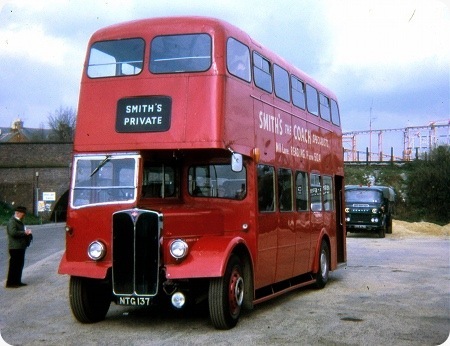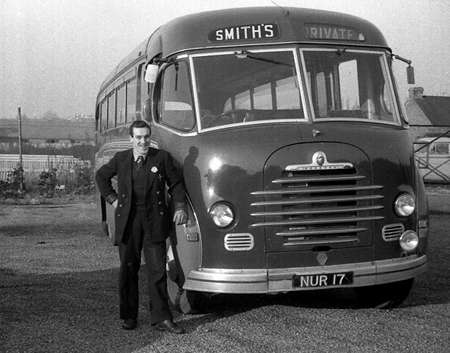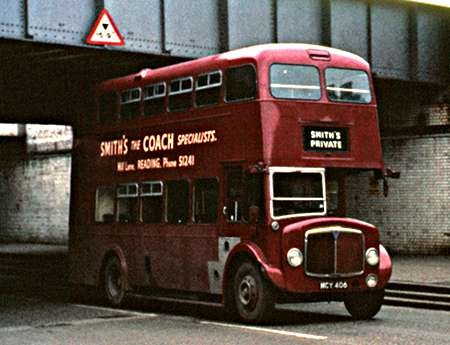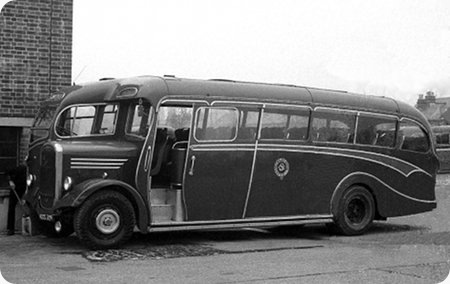
Photograph by Graham Low
Smiths Luxury Coaches (Reading) Ltd
Dennis Lancet J3
1947-50
Duple C35F
I read with great interest Frank and Derrick’s notes on the Dennises run by Prestwells of Woodhouse
Eaves. Unfortunately I’ve no info that might help, but here’s a Dennis Lancet J3 of about 1950 run by
Smith’s of Reading until about 1964. The photo is by Graham Low, who incidentally contributed many of
the illustrations to Paul Lacey’s book "Thames Valley 1946-1960".
Having always found
buses more interesting than coaches I regrettably never noted the registrations of Smith’s Lancets, many
of which had been bought in from other operators. By the mid sixties they were relegated to occasional
contract duties, their place in the front shed having been usurped by nice AEC Reliances and horrible
Super Vega-bodied Bedford SBs.
For single-deck runs on the AWRE Aldermaston contract the
office would say "Take one of the spare Bedfords" but I occasionally managed to persuade them
to let me take a Lancet, and what a pleasure it always was!—though the other younger drivers
didn’t agree.
In Classic Bus Aug-Sept 1999 there’s an amusing account of the challenges posed by
the Dennis Lancet. You don’t sit over the pedals, but more behind them as in a car. The bonnet is
admittedly high, but visibility is still good. First and second gears are to the right, third and fourth
to the left, and for fifth leave the lever in fourth position but push it left towards the engine
against a stiffish spring and then forward. Ease off the throttle and as the revs die back fifth engages
itself noiselessly, and to return to fourth release the throttle for a moment, give her 44% more revs
and again the take-up is smooth and silent. In contrast to this luxury the rest of the box (sliding mesh
for all except fourth) is fairly unforgiving.
The Dennis O6 engine, direct-injection with 4 valves
per cylinder, is quiet, practically vibration-less and very free-revving, but not a low-revs slogger, so
hill-start clutch control can be tricky.
The steering seems rather low-geared, but is light,
extremely positive and—unlike that of some AEC Reliances—dead stable. The brakes are
perfectly adequate. The whole vehicle inspires confidence in the driver, and I don’t think the
passengers ever complained either.
One Smith’s Lancet J3 registration KJH 900 was bought for
trolleybus towing by the very active preservationist Tony Belton. I’ve heard it may survive somewhere.
It has come to light whilst doing this posting that the above vehicle was in fact KXX 329 and came from
Clarkes Luxury Coaches, London E16, in about 1951-2
Photograph and Copy contributed by Ian Thompson
———
It’s interesting that Dennis were never mainstream but always managed to have
a mainstream following - even in the ’50s.
Considerable numbers of Lancet IIIs had full and
productive lives with Yorkshire Traction and East Kent - let alone with their biggest fan, Aldershot
and District.
Was I dreaming - or did Smith’s eventually become Horseman Coaches of
Reading?
David Oldfield
———
Yes, David; Smith’s did become Horseman. The old blue and orange livery gave
way to white. I’m hoping to get more details of the takeover soon. The Lancet J3 was so well made
that I’m sure many of them would have had even fuller lives had one-man operation not demanded front
entrance and so the disappearance of the halfcab. Interesting that the underfloor Lancet attracted
so few customers and that A&D in particular turned their backs on it. I’ve never driven one, but 3
possible explanations come to mind:
a) Did the 8-litre version of the Dennis O6 engine work
less well lying down than standing up? Piston wear problems? Only a guess…
b) Was the
sound of the mid-mounted engine too subdued for the driver to judge revs accurately enough for clean
gear changing?
c) Were the mechanical losses incurred by the double-reduction rear axle
reflected in noticeably higher fuel consumption?
Ian Thompson
———
Getting very technical here, Ian, but everything you say makes sense. The
AH590 was not the AV590 and the vertical and horizontal 0.600 were not strictly the same engine.
Dennis were always small and probably didn’t have the money to throw at solving problems of turning
an engine on its side. [Even Volvo had to use government money. They piggy-backed development of B58
with horizontal engine on a government contract for military vehicles with similar layout. Otherwise
Volvo may have been in with horizontal engines later than they were.] I’m no expert on early
Dennises, but it was reported that the 06 was very smooth. As for the fuel consumption, if all else
were right, people would perhaps have persevered. I heard that K4 Lances suffered twisted chassis at
A&D, but I don’t know whether this was universal.
At least they gave the general populous a
Lodekker.
David Oldfield
———
Only very few horizontal O6 Dennis engines were 8 litres and with this engine
there were reported problems of bearing failures from Glentons. The engine power was increased from
the vertical engine by increasing the allowable revs and I am thinking that Glentons (on tour work)
probably used this to advantage for long periods. The 7.6 litre horizontal engine does not seem to
carry this stigma.
All the horizontal engines differed from the vertical models - an oil way
was drilled up the connecting rod to supply extra oil to the piston bores. I have often wondered if
this was excessive and it robbed the bearing supply.
Nick Webster
———
18/03/11 - 16:13
I was based at RAF White Waltham, 1963 - 1967, and regularly used Smiths of
Reading for Wednesday afternoon football fixtures. More importantly, Smiths had a daily contract to
ferry our lovely WRAF personnel from RAF Shinfield Park where they were billeted, to RAF White
Waltham, where they worked. The usual driver for this daily run was a veritable Mr Banks, who was 70
at the time, drove like a mad thing, and read my wife’s (to be) newspaper whilst driving if she sat
near the front. Rumour has it that other, younger drivers were terrified of standing in for Mr Banks
if he was away, as he would seek feedback on their behaviour and driving on his return.
Sorry,
this isn’t a technical item, but it might add a bit of whimsical history.
Now, if anyone has a
photograph of Mr Banks, with or without coach and WRAF beauties, that would be worth seeing.
Doug Adams
———
26/04/11 - 07:19
I left school in 1955, and started work at Smith Coaches in the engine shop
with Bill Collins, and after coming out of the Army in 1964 I returned, passed my PSV and worked
with them until 1970. Having driven all types of buses "AEC/Leyland and ex London RT’s",
working in the garage with Nobby Early, Coaches on Contract duties, and Coastal Services,
Continental Tours with Eric Mills, I now find it hard to believe that the largest one man operator,
with a fleet of approx 120 vehicles I now find little trace that they ever existed. Mr Alf Smith was
once Mayor of Reading
Pete Brant
———
27/04/11 - 07:13
Good to read Pete Brant’s comment. I’m glad to say, Pete, that some of the old
hands are still around. Sadly, it was Charlie Heath’s recent funeral that brought some of us
together: I met Bunny Austin, Pete Smyth, Ron Shackleford (still working part-time for Horseman, Jim
Foster and (though I didn’t get a chance to talk to him) Bert Newman. I think we ought to have
annual reunions! Very few Smith’s buses have survived: Ron S.’s Reliance, under cover at a museum
east of Reading, is the only one I know of. I heard the other day that Dennis Lancet KJH 900, used
for years as a towing wagon for preserved trolleybuses, hasn’t made it.
So the vehicles have
all but gone and Rose Kiln Lane depot is built over, but-thank Heaven-some familiar faces are still
around and Graham Low of Wokingham has plenty of photographs that he very foresightfully took in the
50s and 60s. Bunny Austin too has a collection of on-tour photos and apparently Jim Foster even has
some cine-film.
Ian Thompson
———
27/04/11 - 07:19
Hi Ian I also remembered the Rhonda Regents,the only vehicle you could bring
up Southampton Street in top gear, due to low ratio gearbox, also was fitted with exhaust brake. Do
you remember the old "ex Leeds Leyland JUG" we used on the Crowthorn Road Reserch contract
during the construction.
Pete Brant
———
01/05/11 - 09:25
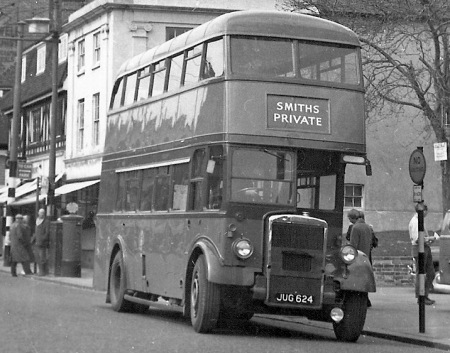
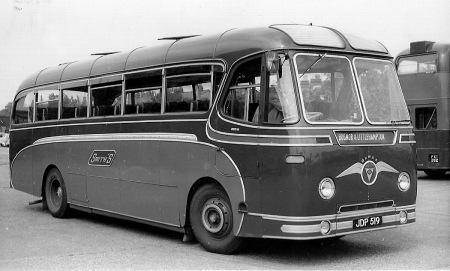
A couple of photos in connection with Pete Brant’s comment on Smith’s of
Reading. JUG 624 (1946 Leeds PD1 but with 1945 chassis number) stands in St Mary’s Butts and JDP 519
(new to Smiths in 1953) which I used a lot when not on double-deck contracts, is in the yard, with
one of the prewar London RTs in the background. Two JUGs (the numbers escape me) were always used on
the "Paddy Run" to Crowthorne and were white with dust inside from the clothes of the
always good-humoured Irish labourers, who’d regale each other with wonderful tales in the tradition
of the roving story-tellers of rural Ireland. There was a stop on the way back at the Jack of Both
Sides at Cemetery Junction, but in the n/s mirror you could always see a handful of thirsty chaps
leaping off the platform well before you reached the pub. I worked this enjoyable run quite a lot,
mostly with the late Mike Dare, who co-founded the Sandtoft Trolleybus Museum.
You mention the
good hill-climbing of the Rhondda Regent IIIs, Pete. I wonder whether that was also because of the
9.6-litre engine and lightweight bodywork?
Len Ledger was the driver and guardian of London RT
FXT 229, and you had to be on your best behaviour to be allowed to drive it!
Ian Thompson
———
04/05/11 - 07:10
So many wonderful memories Ian, on many occasions I was privileged to drive
Lens RT with the coconut matting on the cab floor for those dirty people that didn’t remove their
shoes before entering the cab. I was so sorry to hear of Charlie Heaths passing, glad to hear Ron
Shack is still doing a bit, Tell him "Herman the German was asking after him. Do you know if
Mick Smith "the Govenor’s Son" is still with us,? I last saw Keith Aplin at Horsemans a
few days before he retired.
Pete Brant
———
 Vehicle reminder shot for this posting
Vehicle reminder shot for this posting
———
17/05/11 - 11:18
It was wonderful to read your comments about Smith Coaches. My father is Jim
Avenell who is still with us at 80yrs young. I spent my childhood either down the yard or out in the
coach with my father during the early to mid sixties and in the social club between runs lol, I was
always there. Saturday mornings would be spent emptying the ash trays and polishing them with
Duraglit while dad was on the wash in his wellies doing the outside, we’d then go up to the canteen
for a cuppa and I would sit in ore listening to all the guys talking and joking around, the room
full of smoke from woodbines and parkdrive, plenty of tea. Then back down to the wash and polish the
body trims, oh I loved it.
We used to keep a pony on the grass behind the social club and
people would feed it beer and crisps through the window, never forgetting the Christmas parties for
us kids, Happy days sitting up front going to Harwell sitting in the shed on site, or going to
Abingdon cattle market. One day we bought a dozen chicken and brought them back to Reading in the
boot lol Oh so many stories. I have amassed a couple of hundred photos over the years and always
looking for more or any thing related. Some of the guys I remember were great, guys like Robby
Curtis, Ron Shack of course, Dave doe, Jack Pit, Reggy Summerfield,Grover,Steel,Kenny Haywood,Punchy
Parsons,Chris Denton,Mick Goslin, Pete Fisher, Morri Hood, Ceral Gollop, Ropper, Dave Reed, Gorge
Forman, Alf, Michal and Jacky Smith. Im sure I could think of more. So many good memories and all
that’s left is the row of conifers that lined the wash.
I myself later drove for Horsemans
briefly before getting my class one HGV, Later to become an HGV driving assessor, so I guess you
could say its in the blood and the seeds where sown down at Smiths Luxury Coaches.
Paul Avenell
———
17/06/11 - 09:00
Response to Paul Avenell.
Paul does your great collection of photographs
contain any of the veritable Mr Banks? When your Dad was approx. 30, Mr B. was 70 (but still driving
for Smiths), perhaps he might remember him. In any case, very best wishes,
Doug Adams
———
24/02/12 - 07:15
9797 DP a Val 14 Duple is still with us!
Anon
